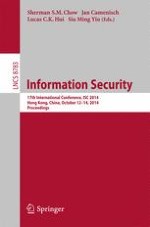This book constitutes the refereed proceedings of the 17th International Conference on Information Security, ISC 2014, held in Hong Kong, China, in October 2014.
The 20 revised full papers presented together with 16 short papers and two invited papers were carefully reviewed and selected from 106 submissions. The papers are organized in topical sections on public-key encryption, authentication, symmetric key cryptography, zero-knowledge proofs and arguments, outsourced and multi-party computations, implementation, information leakage, firewall and forensics, Web security, and android security.
